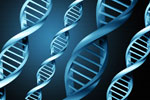April 4, 2011
 In the largest study of its kind to date, a team of American researchers has identified four new genes that appear to be linked to Alzheimer’s in old age. Another group of researchers, working in Europe and with the first group, identified a fifth gene linked to the disease. The findings could shed new light on why people develop Alzheimer’s and open up new ways of treating the debilitating illness.
In the largest study of its kind to date, a team of American researchers has identified four new genes that appear to be linked to Alzheimer’s in old age. Another group of researchers, working in Europe and with the first group, identified a fifth gene linked to the disease. The findings could shed new light on why people develop Alzheimer’s and open up new ways of treating the debilitating illness.
The American study was what’s known as a genome-wide association study, the gold standard in genetic research, and looked at the entire genetic makeup of more than 56,000 men and women, about a fifth of whom had Alzheimer’s disease. The European study also looked at tens of thousands of volunteers. Using gene chips and other novel technologies, they identified subtle differences between those with or without Alzheimer’s. Five genes were linked to late-onset Alzheimer’s, by far the most common form of the disease that typically arises after age 60.
“By comparing people diagnosed with Alzheimer’s with people free of disease symptoms, researchers are now able to discern elusive genetic factors that may contribute to risk of developing this very devastating disease,” said Dr. Richard J. Hodes, director of the National Institute on Aging, which sponsored the U.S. study. “We are entering an exciting period of discoveries in genetics that may provide new insights about novel disease pathways that can be explored for development of therapies.” The findings from both studies appeared in the scientific journal Nature Genetics.
Doctors have long known that Alzheimer’s disease runs in families. Having a family member with the disease increases the risk you will get it, and the disease is also more common in identical twins than in fraternal ones. But identifying genes has been elusive.
The first gene to be linked to late-onset Alzheimer’s was APOE-E4, identified in 1995. In the past several years, four other genes were identified. The latest research identified four new Alzheimer’s genes— called MS4A, CD2AP, CD33, and EPHA1 — and helped confirm the role of two other genes, BIN1 and ABCA7. The findings doubled the number of genes known to play a role in Alzheimer’s disease, bringing the total to 10. Other genes are associated with the far less common early-onset Alzheimer’s disease, which runs in families and arises in people younger than 50.
APOE-E4 appears to confer the greatest risk of developing Alzheimer’s in old age, typically between the ages of 60 and 80. Inheriting a copy of the gene from one parent doubles or triples the lifetime risk that you might get the disease, though having the gene by no means guarantees that you will get Alzheimer’s. Inheriting two copies of the gene, one from each parents, increases risk by five-fold.
None of the newer Alzheimer’s genes confer anywhere near the risk that the APOE gene does. Carrying the genes increases risk only slightly, and doctors are not proposing that you get tested for them. But all share common properties that shed new light on the development of Alzheimer’s and could open the way to new therapies for treating the disease.
All the genes appear to play a role in the way that the body processes cholesterol, a blood fat that is known to play a role in heart disease. They also appear to be linked to inflammation, which also plays a role in heart disease. Both inflammation and cholesterol metabolism are recognized as factors in Alzheimer’s and other types of dementia as well.
“This is the culmination of years of work on Alzheimer’s disease by a large number of scientists, yet it is just the beginning in defining how genes influence memory and intellectual function as we age,” said Dr. Gerard D. Schellenberg, a study leader from the University of Pennsylvania, one of the more than 44 medical centers involved in the research. “We are all tremendously excited by our progress so far, but much remains to be done, both in understanding the genetics and in defining how these genes influence the disease process.”
Now, the European and American groups are pooling their data to do an even larger study of the effects of genes on Alzheimer’s disease.
By ALZinfo.org, The Alzheimer’s Information Site. Reviewed by William J. Netzer, Ph.D., Fisher Center for Alzheimer’s Research Foundation at The Rockefeller University.
Sources: Paul Hollingworth, Denise Harold, Rebecca Sims, Amy Gerrish, et al: Common variants at ABCA7, MS4A6A/MS4A4E, EPHA1, CD33 and CD2AP are associated with Alzheimer’s disease. Nature Genetics, April 3, 2011.
Adam C Naj, Gyungah Jun, Gary W Beecham, Li-San Wang, et al: Common variants at MS4A4/MS4A6E, CD2AP, CD33 and EPHA1 are associated with late-onset Alzheimer’s disease. Nature Genetics, April 3, 2011.
Rush University, University of Pennsylvania, National Institute on Aging.
|
“The new gene data along with our recent findings could lead to an earlier detection of Alzheimer’s disease. Our scientists are striving to find new treatments be able to introduce to individuals before the progression of Alzheimer’s disease begins,” says Kent L. Karosen President and CEO of the Fisher Center for Alzheimer’s Research Foundation. For more information on the latest discoveries Nobel laureate Dr. Paul Greengard and his scientist at the Fisher Center for Alzheimer’s Research laboratory, please visit: Fisher Scientists Discover New Was to Rid Cells of Alzheimer Protein |












